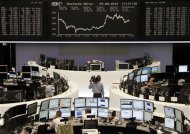RELATED CONTENT
 View PhotoA cameraman stands in front of the DAX board at the Frankfurt stock exchange August 29, 2012. REUTERS/Remote/Lizza May David
View PhotoA cameraman stands in front of the DAX board at the Frankfurt stock exchange August 29, 2012. REUTERS/Remote/Lizza May David
By Richard Hubbard
LONDON (Reuters) - European shares crept higher on Monday after weak factory data highlighted the poor health of the global economy, keeping alive talk of fresh stimulus from major central banks.
However, with U.S. investors out for the Labor Day holiday, markets were stuck in a limited range.
Expectations that central banks would soon take steps to boost growth increased after separate surveys showed manufacturing activity in China and Europe slowing by more than expected in August.
"I think we're going to see more stimulus from pretty much every central bank on the face of the planet," said Michael Ingram, market analyst at BGC Partners.
"We're living in a globalised economy. It's a globalised slowdown. So policy makers have to step up to the plate."
The hopes helped lift the FTSEurofirst 300 index (.FTEU3) of top European shares 0.5 percent on Monday to 1,088.80 points, adding to gains of 0.5 percent on Friday.
The MSCI world equity index <.MIWD00000PUS> was barely changed at 322.40 points, but it had ended seven straight down days on Friday when investors decided U.S. Federal Reserve Chairman Ben Bernanke was open to further stimulus if needed.
After Bernanke made his remarks to central bankers in a speech at Jackson Hole in Wyoming the euro had hit an eight-week peak of $1.2638. It remained steady just below this level at $1.2570 on Monday.
EYES ON ECB
Any move by the Fed is seen as unlikely before its next policy meeting, which runs from September 12-13, and will be heavily dependent on the outcome of Friday's August payrolls report which could add to recent signs of a gradual U.S. recovery.
In the meantime, the market's main focus is on the European Central Bank meeting this Thursday, where expectations are rising that it may cut its main interest rates, already at record lows.
The likelihood of a rate cut grew on Monday after the final Purchasing Managers' Index (PMI) reading for the factory sector in August showed activity across the region contracting at an accelerating rate.
The euro area index fell to 45.1 from an initial estimate of 45.3, notching its 13th month below the 50 mark that separates growth from contraction.
The data also confirmed that a downturn which had begun in the smaller peripheral members of the 17-nation bloc has now spread to the core nations of Germany and France, and that the region's third and fourth biggest economies of Italy and Spain are still weakening.
"The general picture is one in which we are losing momentum," said Peter Dixon, an economist at Commerzbank.
"Growth is going to struggle, not just in the euro zone but everywhere, over the next few months until authorities find a way to inject some positive sentiment," he said.
The ECB releases its latest economic projections for the euro area at Thursday's meeting, on the same day that Europe's statistics agency Eurostat is likely to announce the region's economy contracted by 0.2 percent in the second quarter.
Markets are also expecting the ECB to release details of its new bond-buying plan to ease the region's debt crisis on Thursday. Many central banks say that crisis is the prime cause of the global slowdown in economic activity.
The prospect of ECB bond buying helped 10-year Spanish bond yields to fall 1.5 basis points on Monday to 6.9 percent, while two-year yields shed 21 basis points to 3.52 percent.
COMMODITY STIMULUS
In oil markets, the latest surveys on factory activity, in particular the unexpected weakness in China, the world's No.2 oil consumer, saw prices initially ease; but the possibility of more stimulus measures saw prices quickly recover.
Brent October futures were up 40 cents at $114.97 per barrel, steadying after jumping nearly $2 on Friday. U.S. crude futures were little changed at $96.48.
"The Chinese data is very gloomy and suggests that the world economy is slowing," said Carsten Fritsch, oil analyst at Commerzbank in Frankfurt. "But the market impact is rather limited as it raises hopes of more economic stimulus measures."
Gold held around five-month highs of $1,686.96 an ounce posted on Friday as any sign of more monetary easing from the world's major central banks makes the precious metal more appealing to investors as a hedge against potential inflation.
Speculation the Fed may be about to act lifted the gold price by 4.8 percent in August, marking its third successive monthly gain and the largest one-month increase since January.
Gold has now doubled in price since the Fed first employed quantitative easing, the practice of buying government debt on the secondary markets to keep rates low and liquidity high, in late 2008.
(Additional reporting by Jonathan Cable and Christopher Johnson; Editing by Anna Willard and Alastair Macdonald)

No comments:
Post a Comment